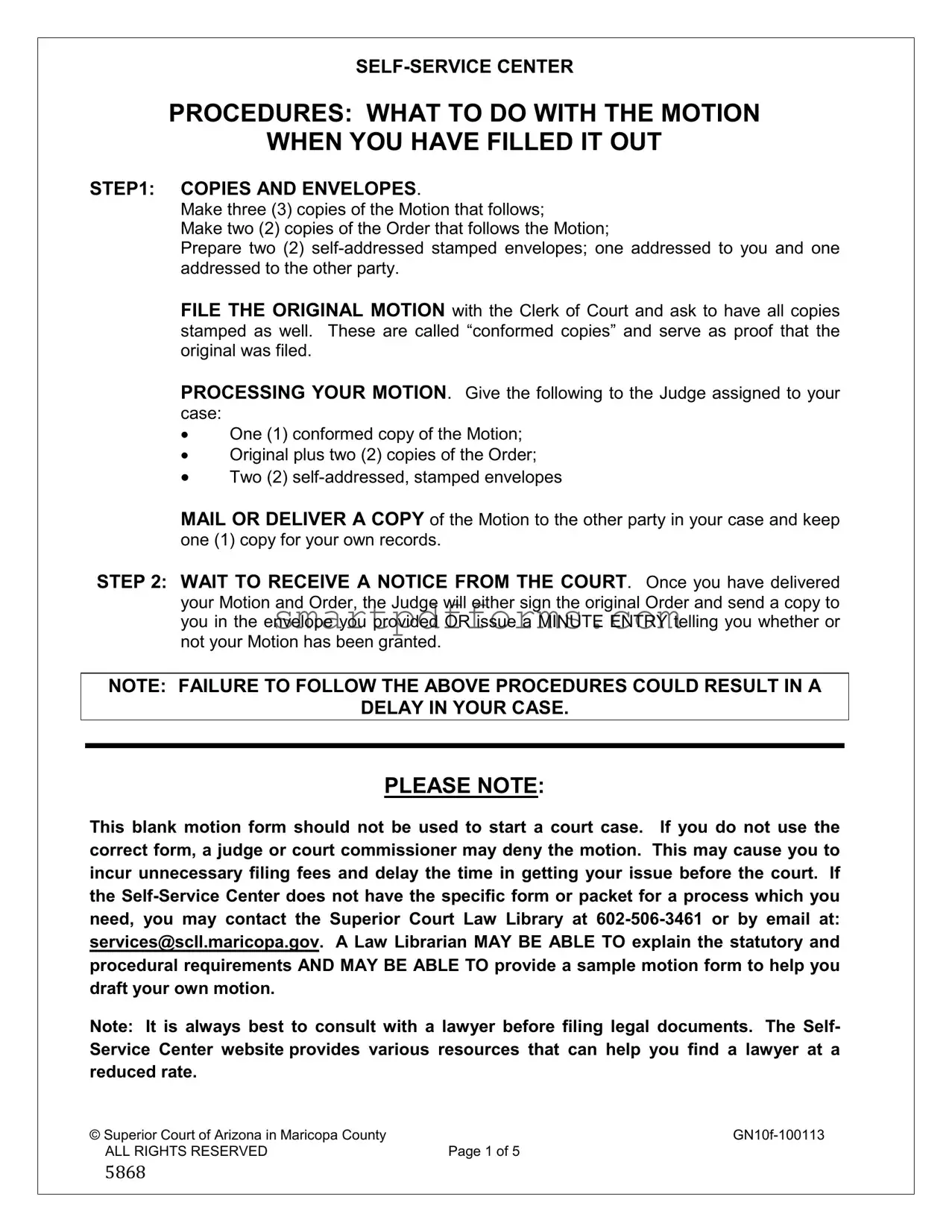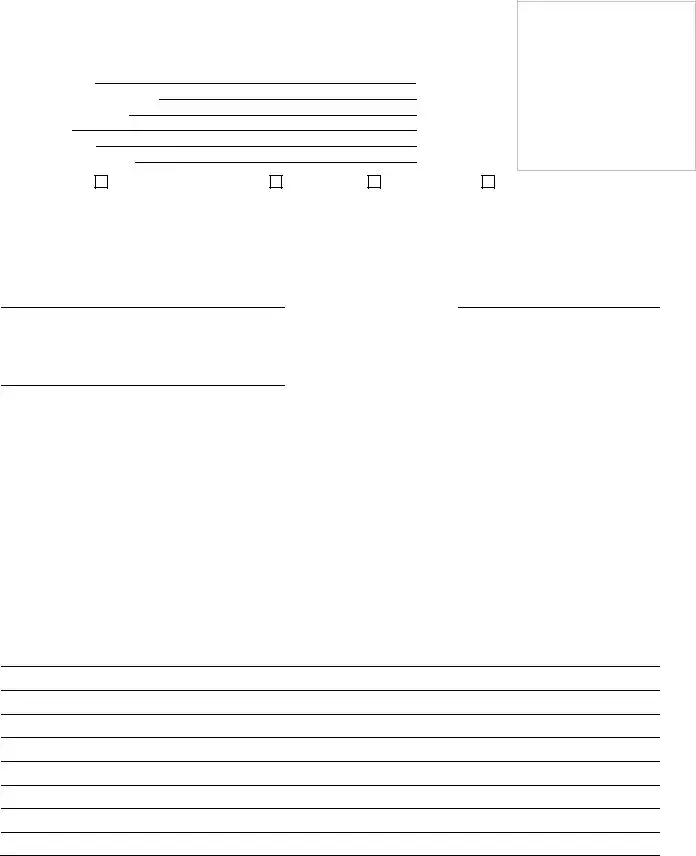
SELF-SERVICE CENTER
PROCEDURES: WHAT TO DO WITH THE MOTION
WHEN YOU HAVE FILLED IT OUT
STEP1: COPIES AND ENVELOPES.
Make three (3) copies of the Motion that follows;
Make two (2) copies of the Order that follows the Motion;
Prepare two (2) self-addressed stamped envelopes; one addressed to you and one addressed to the other party.
FILE THE ORIGINAL MOTION with the Clerk of Court and ask to have all copies stamped as well. These are called “conformed copies” and serve as proof that the original was filed.
PROCESSING YOUR MOTION. Give the following to the Judge assigned to your case:
•One (1) conformed copy of the Motion;
•Original plus two (2) copies of the Order;
•Two (2) self-addressed, stamped envelopes
MAIL OR DELIVER A COPY of the Motion to the other party in your case and keep one (1) copy for your own records.
STEP 2: WAIT TO RECEIVE A NOTICE FROM THE COURT. Once you have delivered your Motion and Order, the Judge will either sign the original Order and send a copy to you in the envelope you provided OR issue a MINUTE ENTRY telling you whether or not your Motion has been granted.
NOTE: FAILURE TO FOLLOW THE ABOVE PROCEDURES COULD RESULT IN A
DELAY IN YOUR CASE.
PLEASE NOTE:
This blank motion form should not be used to start a court case. If you do not use the correct form, a judge or court commissioner may deny the motion. This may cause you to incur unnecessary filing fees and delay the time in getting your issue before the court. If the Self-Service Center does not have the specific form or packet for a process which you need, you may contact the Superior Court Law Library at 602-506-3461 or by email at: services@scll.maricopa.gov. A Law Librarian MAY BE ABLE TO explain the statutory and procedural requirements AND MAY BE ABLE TO provide a sample motion form to help you draft your own motion.
Note: It is always best to consult with a lawyer before filing legal documents. The Self- Service Center website provides various resources that can help you find a lawyer at a reduced rate.
© Superior Court of Arizona in Maricopa County |
GN10f-100113 |
ALL RIGHTS RESERVED |
Page 1 of 5 |
Person Filing: |
|
|
|
|
Address (if not protected): |
|
|
|
City, State, Zip Code: |
|
|
|
Telephone: |
|
|
|
|
Email Address: |
|
|
|
|
Lawyer’s Bar Number: |
|
|
FOR CLERK’S USE ONLY |
Representing |
Self, without a Lawyer or |
Attorney for |
Petitioner OR |
Respondent |
SUPERIOR COURT OF ARIZONA
IN MARICOPA COUNTY
Case Number:
Name of Plaintiff or Petitioner
Title:
Name of Defendant or Respondent
Explain what you want the Court to order. The Judge may grant, deny, or change your request (or “motion”). A ruling will be issued by “minute entry.”
© Superior Court of Arizona in Maricopa County |
GN10f-100113 |
ALL RIGHTS RESERVED |
Page 2 of 5 |
5868
Today’s Date:
Your Signature
© Superior Court of Arizona in Maricopa County |
GN10f-100113 |
ALL RIGHTS RESERVED |
Page 3 of 5 |
5868
Case No.
This page must be completed and attached to the LAST page of your Motion/Request
I filed the ORIGINAL of the attached document(s) with the Clerk of the Superior Court
in Maricopa County on: |
|
|
|
. |
|
Month |
Date |
Year |
I mailed/delivered a COPY of the attached document(s) to the Judicial Officer assigned
to my case, Judge (or Commissioner): |
|
, on |
|
(Judicial Officer assigned to your case) |
Month Date Year
I mailed/delivered a COPY of the attached document(s) on this date:
To: __________________________________
Month Date Year
(You must mail a copy of all documents to the other side and his/her lawyer)
Name of Other Side |
Name of Other Side’s Lawyer |
|
|
Address |
Lawyer’s Address |
|
|
City, State, Zip |
City, State, Zip |
By signing below, I state to the Court, under penalty of law, that the information stated on these pages is true and correct to the best of my knowledge and belief.
I further state that I have filed/mailed the attached document(s) as shown above. I understand that if I do not file/mail the attached document(s) as shown above, the judge in my case will not read my request/motion.
Your signature
© Superior Court of Arizona in Maricopa County |
GN10f-100113 |
ALL RIGHTS RESERVED |
Page 4 of 5 |
5868
Person Filing: |
|
|
|
|
Address (if not protected): |
|
|
|
City, State, Zip Code: |
|
|
|
Telephone: |
|
|
|
|
Email Address: |
|
|
|
|
Lawyer’s Bar Number: |
|
|
FOR CLERK’S USE ONLY |
|
|
|
|
Representing |
Self, without a Lawyer or |
Attorney for |
Petitioner OR |
Respondent |
SUPERIOR COURT OF ARIZONA
IN MARICOPA COUNTY
Case Number:
Name of Plaintiff or Petitioner
ORDER
Name of Defendant or Respondent
When you submit a motion [a request] to the Court, you may submit your own proposed version of the Order you want the Judge to sign. IF this motion is a stipulation [an agreement or joint request] presented by two or more parties, you MUST submit your own proposed version of the Order. [Maricopa County Local Rule 3.2 (i)(1)].
The Judicial Officer will make a decision on your request and may sign the page that you submitted, or more likely will direct the Clerk to make a “minute entry” recording the decision. A “minute entry” is a note in the records of the Court’s proceedings. The minute entry will be printed, reviewed, approved and signed by the Judge, and sent to all parties.
If you have submitted your own proposed Order, you must include a copy of the Request and the Order and a stamped envelope addressed to each party who has “entered an appearance” in the case. This means named parties or anyone that has filed papers in the case. [Maricopa County Local Rule 3.2 (i)(1)].
IT IS ORDERED THAT:
DONE IN OPEN COURT: |
. |
|
|
|
|
|
|
|
JUDGE/COMMISSIONER |
|
© Superior Court of Arizona in Maricopa County |
|
|
GN10f-100113 |
ALL RIGHTS RESERVED |
|
Page 5 of 5 |
5868





